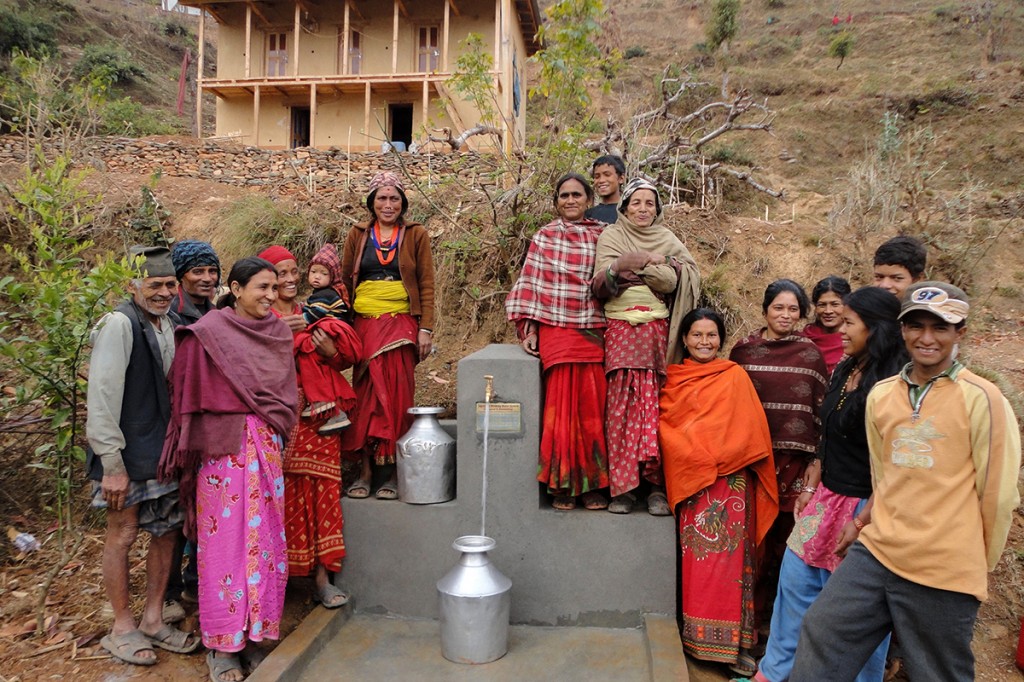Since 2000, World Neighbours Canada has been using WNC and matching CIDA funds to put in sealed, hygienic toilets in many villages of Nepal. What at first was a hard sell to villagers who have practiced ‘open defecation’ all their lives, has now become a highly requested item. Our partner, Tamakoshi Sewa Samiti (TSS), has been fielding increasing numbers of requests from villages who already have a water system in place, to help with the installation of the new toilet. Outhouses and pit toilets have been tried in the past, but there has always been problems with smell and with the attraction of unwanted pests, vermin and insects. The design of the sealed, hygienic toilet overcomes these issues.
Nepal Report

The loss of CIDA matching funding has resulted in a drop in activity in Nepal over the past year, but TSS has still managed to install 3 water systems in the villages of Saduagaun, Jagirgaun and Kyama. Funding was partially from WNC, but also from Rotary International via Rotary Aldergrove, and from a student based NGO called CACTES (Caring About Communities Together to Eliminate Struggle) from Surrey, BC. The three systems combined have brought water to a total of over 500 people. Unfortunately, the toilet program has been suspended because of lack of funding.
In the coming year, we plan to concentrate on toilets again, especially in the villages that now have water. We have seen the combination of accessible water and sealed, hygienic toilets reduce gastrointestinal diseases by 80%, and the requests from villages for toilets is as high as ever.
Nepal Political Update
Nine months after the Constituent Assembly elections and six months after Cabinet formation, the government has nominated 17 lawmakers in 26 vacant CA seats only on 30 August, 2014.
The 26 seats were allotted to different political parties as per their seats in CA. Eight of the nominees are from the Nepali Congress, eight from CPN-UML and one from the RPP-Nepal while the four seats allocated to the opposition UCPN (Maoist) and four others to fringe parties are yet to be filled. As per the mandate of CA, the new full-fledged constitution has to be promulgated by 22nd January 2015.
Most of the lawmakers have stressed on the need to deliver the new constitution within the stipulated time-frame either through consensus, if not through voting process. However, the major issues are yet to finalize no. of federal states, its naming and bordering as well as the executive power (Presidential or Pri-ministerial). At present, the executive power is vested to the Pri-minister.
There are still 33 political parties (including faction of Maoist and others) who lost and/or did not take part in the last CA election. Last week, the ruling government had called all-party national political conference to reach consensus on major issues including federalism, governance system and electoral system. However, the 33-party alliance boycotted the meeting in the last minute where participants from other parties waiting in conference room. The consensus has not yet reached on these thorny issues among the ruling parties as well. It is still suspicious that the new constitution be delivered by 22nd January, 2015.
From desert dates to soap
The challenges of development in the Sahel
 Imagine what a difference it would make to a woman’s life if she were able to earn a little money of her own through the creation of a saleable product and then sell that product at a local market. That’s just what some Burkinabe villagers have been able to do: they have learned how to extract oil from desert dates and then use that oil to make soap.
Imagine what a difference it would make to a woman’s life if she were able to earn a little money of her own through the creation of a saleable product and then sell that product at a local market. That’s just what some Burkinabe villagers have been able to do: they have learned how to extract oil from desert dates and then use that oil to make soap.
Recent reports from APDC, World Neighbours Canada’s partner organization in Burkina Faso, have provided details about the project. In addition to the forest products initiatives such as the soap making, the villagers are pleased with the achievement of a local radio broadcast about forestry clearing laws and protection measures, improvement in agricultural yields through the use of green manure, and animal health improvements.
Archives
Welcome to World Neighbours Canada
World Neighbours Canada Society was founded in Oliver, B.C. in 1989. Programs are currently active in three program areas: Nepal in Asia, Burkina Faso in Africa and Honduras, in Central America.
2013 Project Completion Report
Ramechhap Drinking Water, Sanitation and Smokeless Stoves Project
by Dale Dodge
Feb. 5, 2014
The Project Completion Reports document all of the details of the communities where gravity fed water systems, hygienic toilets and smokeless stoves have been constructed.
Nepal Political Update
Nepali Congress President was elected as the 37th Prime Minister yesterday. He has secured 405 lawmakers votes while 148 voted against him including the Maoist lawmakers.
He has been administered the oath of office and secrecy by the President today. The newly elected Prime Minister has expressed to give a full-fledged constitution in the next one year.
Likewise, the Chairman of the interim election government has been automatically released and he has been also resigned from the post of Chief Justice. When he was elected he was Chief Justice of the Supreme Court and he was holding the both posts until today.
Nepal Election Results
The Election Commission has allotted the seats to political parties on the basis of the number of votes received by them under proportional electoral system. The final result of the seats (direct and proportional election) is as follows:
Honduras Free Trade Agreement Alert
Canada signed a free trade agreement with Honduras on 5 November. The agreement has had little coverage by Canadian media, despite the violence that is pervasive in Honduras. Our partner organization in the country reports that violence is a serious impediment to rural development. Note also that elections are scheduled in Honduras on 24 November. We urge Canadians to learn about the situation in Honduras and the implications of a free trade agreement with Canada. For more information please check out the following links.
Announcement from Foreign Affairs, Trade and Development Canada:
http://www.international.gc.ca/trade-agreements-accords-commerciaux/agr-acc/honduras/info.aspx?lang=eng
Editorial by the Americas Policy Group of the Canadian Council for International Cooperation:
http://www.ccic.ca/_files/en/working_groups/2013_May_APG_OpEd_Honduras.pdf
Articles on the free trade agreement and the Honduras election by the American-Canadian organization Rights Action:
http://rightsaction.org/.

